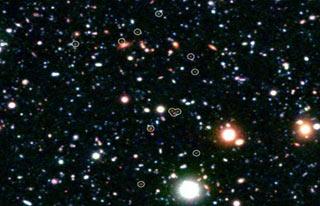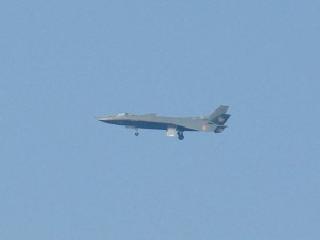
Astronomers have discovered a massive cluster of young galaxies forming in the distant universe. Photo: Subaru/NASA/JPL-Caltech.
WASHINGTON (BNS): Astronomers have uncovered a burgeoning galactic metropolis, the most distant known in the early universe. This ancient collection of galaxies presumably grew into a modern galaxy cluster similar to the massive ones seen today.
The developing cluster, named COSMOS-AzTEC3, was discovered and characterized by multi-wavelength telescopes, including NASA's Spitzer, Chandra and Hubble space telescopes, and the ground-based W.M. Keck Observatory and Japan's Subaru Telescope, according to a news report by NASA.
"This exciting discovery showcases the exceptional science made possible through collaboration among NASA projects and our international partners," Jon Morse, NASA's Astrophysics Division director at NASA Headquarters in Washington, was quoted as saying in the report.
Scientists refer to this growing lump of galaxies as a proto-cluster. COSMOS-AzTEC3 is the most distant massive proto-cluster known, and also one of the youngest, because it is being seen when the universe itself was young. The cluster is roughly 12.6 billion light-years away from Earth. Our universe is estimated to be 13.7 billion years old. Previously, more mature versions of these clusters had been spotted at 10 billion light-years away.
The astronomers also found that this cluster is buzzing with extreme bursts of star formation and one enormous feeding black hole, the report added.
"We think the starbursts and black holes are the seeds of the cluster. These seeds will eventually grow into a giant, central galaxy that will dominate the cluster -- a trait found in modern-day galaxy clusters," said Peter Capak of NASA's Spitzer Science Center at the California Institute of Technology in Pasadena.
Capak and his colleagues first used the Chandra X-ray Observatory and the United Kingdom's James Clerk Maxwell Telescope on Mauna Kea, Hawaii, to search for the black holes and bursts of star formation needed to form the massive galaxies at the centers of modern galaxy cities. The astronomers then used Hubble and the Subaru telescopes to estimate the distances to these objects, and look for higher densities of galaxies around them. Finally, the Keck telescope was used to confirm that these galaxies were at the same distance and part of the same galactic sprawl.
Once the scientists found this lumping of galaxies, they measured the combined mass with the help of Spitzer. At this distance the optical light from stars is shifted, or stretched, to infrared wavelengths that can only be observed in outer space by Spitzer. The lump sum of the mass turned out to be a minimum of 400 billion suns -- enough to indicate that the astronomers had indeed uncovered a massive proto-cluster.
The Spitzer observations also helped confirm a massive galaxy at the center of the cluster was forming stars at an impressive rate. Chandra X-ray observations were used to find and characterize the whopping black hole with a mass of more than 30 million suns. Massive black holes are common in present-day galaxy clusters, but this is the first time a feeding black hole of this heft has been linked to a cluster that is so young.
Finally, the Institut de Radioastronomie Millimétrique's interferometer telescope in France and 30-meter telescope in Spain, along with the National Radio Astronomy Observatory's Very Large Array telescope in New Mexico, measured the amount of gas, or fuel for future star formation, in the cluster. The results indicate the cluster will keep growing into a modern city of galaxies.
 Previous Article
Previous Article Next Article
Next Article













The Indian Air Force, in its flight trials evaluation report submitted before the Defence Ministry l..
view articleAn insight into the Medium Multi-Role Combat Aircraft competition...
view articleSky enthusiasts can now spot the International Space Station (ISS) commanded by Indian-American astr..
view article